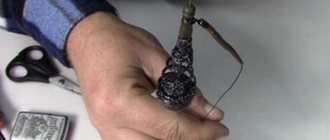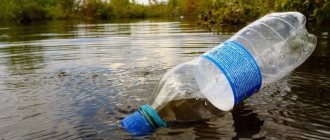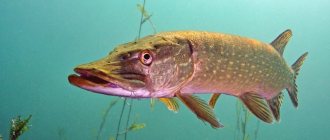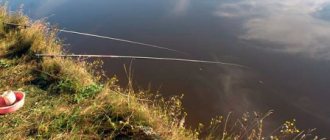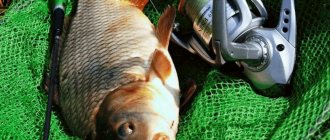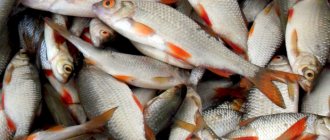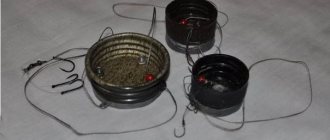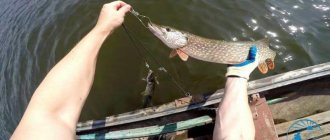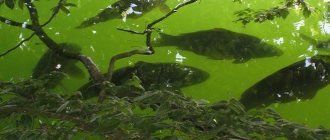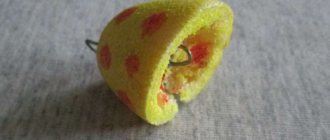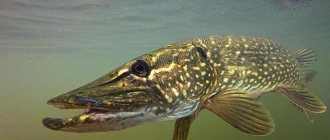Design features of the gear
Grayling fishing tackle is a fishing tackle that is made directly on the main line of the spinning rod used. Using fishing line, two cigar-shaped floats are connected, between which small leashes with flies, 3-5 cm long, are evenly mounted.
You can view photos of the gear here:
Components of grayling gossip
Scheme of gossip on a predator
To make casting as easy and efficient as possible, a weight is placed in the body of the large (end) float. The number of flies may vary, but no more than 10 pieces are mounted on the longest tackle. The presence of a light float ensures the tension of the fishing line in a certain area, preventing it from sagging.
Peculiarities
Grayling fishing is quite an interesting, but not easy, activity. This fish prefers to settle in quiet bodies of water with clean, cool water, so even just finding its habitat can be problematic. However, this is not a reason to give up fishing for grayling. One of the advantages of fishing is that this fish can be caught at any time of the year, it does not hibernate and is quite active. To get a good catch, you need to know the habits of the fish, have experience and choose the right gear.
To find grayling and start fishing, you need to consider the following features: the fish is most often found in the Urals or Siberia, but you can also find it in other regions.
She prefers rivers with fast, swift flows and cool, clear water. There are a large number of ways to catch fish, depending on the habitat and its habits. For example, in deep water a bulldozer or bombard is used. The main thing is that the fishing line is as thin as possible and invisible to the fish. Another way to catch grayling in deep water is to use a Tyrolean fishing rod; in this case, the sinker holds the bait at depth, preventing it from surfacing.
When to use
Grayling is caught using a hook, regardless of the speed of the current in a particular area of the reservoir.
The gear is quite effective, but it is better to plan fishing for the evening, since the potential prey of the predator comes out to play near the surface at this time.
In some situations, it is possible to catch grayling not with dry flies, but with nymphs. In this case, you need to install a removable (additional) float in the center of the tackle.
Grayling fishing can be done throughout the warm period, from spring to late autumn. Gossip, despite its high effectiveness, is not decisive among other types of gear.
Fly fishing
To catch grayling with fly fishing, you need not only to have special gear, but also enormous experience. The ability to handle a fly rod does not come overnight, since the principle of fly fishing is fundamentally different from other types of fishing.
To fly-fish for grayling, you will need a fly rod itself; it cannot be replaced with any other. They, just like spinning rods, differ in structure.
For fishing on rivers that are hidden from the wind and have shallow depths, slow action rods are suitable. Medium action fly fishing poles are considered universal.
They can be used both in deep water and when fishing near the shore.
Fast and Extra fast – rods for fast rivers and large reservoirs. It is also recommended to use them if fishing is accompanied by windy weather.
The reel for fly fishing for grayling should also be special. Depending on the capacity of the spool, it has its own “class”. For fishing on small rivers, a class 3-4 reel is suitable. Don't forget about pre-winding the backing. The larger the spool, the more backing you will need.
For winding onto a reel, fly fishermen most often use braided cord with a diameter of 0.12-0.18. To catch grayling on rivers with large currents, you can replace it with a polyfilament line, which is stronger. Instead of a leash connecting the main line to the fly, a leader is used. Special leader lines can be purchased at any fishing store.
DIY technology
Design of a tyrolean for fishing grayling
For many anglers, it is not clear how to tie such fishing gear as a gossip. But at first glance it seems that it is very complicated. The process of its creation is quite simple, the main thing is to follow the technology of its manufacture. Here you need to prepare a powerful fishing rod and high-quality components.
To make gossip, use:
- plug-in graphite spinning rod, the length of which is over 3 m;
- an inertia-free reel model equipped with a front clutch;
- Braid with a cross section of 0.17 mm is suitable as the main fishing line.
The total length of the fly for grayling can be arbitrary, as can the number of flies. The main thing is that during the fishing process they do not interfere with each other - do not intertwine.
The tackle itself is made on a monofilament line with a cross-section of 0.25 mm, its length should be 250-280 cm. To create floats, you can take hard foam, where one should be about the size of a large chicken egg, and the second - like an orange. A large float is mounted at the end of the gossip, and a smaller one at the beginning. You will also need steel wire with a thickness of 0.3-0.5 mm. The equipment is attached to the main fishing line using a carabiner, which allows, if necessary, quick replacement in case of damage to one of the components of the equipment.
How to catch grayling using a Tyrolean stick
This type of fishing equipment has recently become very popular, so the “Tyrolean stick” is increasingly used by spinning anglers as an alternative to a retractable leash. It is most often used for fishing with small bait, but using long casting. This bait is perfect for catching perch with a medium-sized twister. In this case, a jig head is not needed, because it will only make the bait harder to play, and we need to achieve the greatest naturalness.
- Installation of equipment (what, where and how to attach) ↓
- Tyrolean stick for wobbler ↓
- The process of catching grayling with a Tyrolean stick ↓
- Fishing places ↓
- Wiring ↓
Within the framework of this article, we will outline the features of fishing for grayling using the Tyrolean stick rig .
This type of fishing equipment has recently become very popular, so the “Tyrolean stick” is increasingly used by spinning anglers as an alternative to a retractable leash. It is most often used for fishing with small bait, but using long casting. This bait is perfect for catching perch with a medium-sized twister. In this case, a jig head is not needed, because it will only make the bait harder to play, and we need to achieve the greatest naturalness.
Tackle Tyrolean stick
- absence of snags on algae, stones and various debris at the bottom of the reservoir;
- versatility in use, which allows it to be used together with spinners and other baits;
- long casting range when using the lightest baits;
- very easy assembly and simple wiring;
- possibility of making it yourself;
- low price.
Tackle and its use
To fish with a Tyrolean stick, a rod with a length of 2 to 3 meters is required. The spinning test depends on the fishing location and the weight of the equipment. Usually a form with a load capacity of 15-45 grams is enough. Slow or medium action allows you to support the tackle when it clings to underwater obstacles. An inertia-free reel with a spool size of 2000 to 3000 units according to the Shimano classification is installed on the rod. Instead of a cord, a transparent fishing line with a diameter of 0.18 millimeters is wound.
For equipment you will need:
- float under the current;
- several silicone stoppers;
- swivel;
- leashes with hooks;
- Tyrolean stick.
For fishing in the current, signaling devices with a dense round body are used. Flat products also performed well. There are stoppers on both sides of the float that regulate the depth and free movement of the alarm. A swivel is tied to the end of the main line, onto which a section with leashes is mounted. At the very bottom of the rig there is a Tyrolean stick, which acts as a sinker.
The design of the Tyrolean is quite simple. The elongated product has a lead bottom and a plastic antenna. At the top there is a ring to which the fishing line is tied. When the rig passes through a promising area, the stick taps on the rocky bottom, giving animation to the decoys. At this time, the fisherman monitors the trajectory of the installation, supports the tackle in case of a snag and controls the boat.
You can also fish from the shore using a rig with a Tyrolean stick. Equipped with a long rod, the angler follows downstream. The fishing principle is approximately the same. The equipment moves along the stones, attracting fish with the play of bait. It is important to regulate the wiring speed. It is difficult to do this from the shore, because if the current stops, it washes the Tyrolean stick to the shore. Some anglers use live bait instead of bait. On bad days, their results tend to be higher.
Tackle for grayling with a float for the river
When collecting fishing line for grayling, it is better to wind a fishing line on an inertial reel for a float rod that is strong, but not thick, it is enough to take a fishing line with a diameter of 0.16-0.22 mm, and if there is a possibility that a large trout or brown trout will take it, then it is better to take a fishing line thicker, with a diameter of 0.22-0.28 mm.
When fishing for grayling using float fishing tackle, it is better to take a heavy fixed float, weighing 10-15 grams, and an appropriate sinker for equipping the tackle. After the sinker, it is better to install a small swivel in front of the leash with a hook or jig, so that the leash does not twist the main line under the influence of the current and whirlpools. The leash made from fishing line for the hook must be thinner than the main fishing line, and at the same time, the tackle for grayling must withstand a good large grayling, it is better to make the leash from fishing line with a diameter of 0.12-0.16 mm and a length of 25-40 cm to the hook or jig.
Installation of flies
After completing the technical part, the gossip moves on to attaching flies - bait. For such a distance, as indicated above, it is enough to use 5-6 flies, which are distributed along the entire length of the line every 30-35 cm. Installation is carried out using leashes.
Artificial flies have versatility; with their help you can catch not only grayling, but also other fish. These are durable baits with a long service life.
For information! During the manufacturing process of the tackle, it is necessary to ensure that the leashes do not get confused with each other. Otherwise, a cautious fish will simply bypass this tangled ball.
For fastenings use:
- fishing thread with a cross-section of 0.08-0.1 mm;
- The length of the leash varies depending on the fishing season (in spring it is enough to use leashes 12-14 cm long, and in summer their length can be reduced to 8-10 cm).
Tips for use
- In this case, tying flies is mandatory; without such bait, this tackle becomes useless. The grayling just won’t react to the fishing line.
- The bait for a predator should be as attractive as possible so that it can be immediately noticed. The key point here will be the presence of insects during a specific fishing period. For example, if a mayfly actively moves over a pond and in large numbers, attracting the attention of fish, then the chosen bait should be fully consistent with this type of insect.
- The best option for equipping a gossip is to use several types of bait simultaneously. You can take three things with a light color and three with a dark color. The predator will immediately react to such tackle and inform about its taste preferences.
- A fisherman should have several options of flies in his arsenal in order to identify the most catchable bait through experimentation.
How to make a bulldozer for grayling yourself?
How to make a bulldozer for catching grayling, and what is needed for this? I'm also wondering if there are any special requirements for the shape of the float.
This type of gear has several mounting variations and works great for a huge number of predatory fish, including salmon species. In technical terms, making a fishing rod for grayling is quite simple, but requires compliance with the weight proportions between the sinker and the float, as well as careful selection of the rod, reel, and the thickness of the leader and main fishing line. To simplify the task as much as possible, we will immediately indicate the optimal parameters of the equipment, which demonstrates consistently high catchability on rivers with moderate and fast currents with any type of gravel, rocky or boulder bottom.
The correct setup of a blank for grayling fishing requires the use of medium or slow action rods with a test load of 70-100 g. For fishing from a boat, a blank 2.4-2.4 m long is enough, from the shore - 2.5-3.6 m. Classic installation of the tackle provides for an inertial reel of 130-150 mm, which provides the best control of the bait as it drifts downstream. An inertia-free “meat grinder” (3000-4000) also copes well with this task, if after the request you do not throw the line handle, but slowly release the thread with your fingers. In addition, it remains possible to deliver bait as far and accurately as possible and conveniently switch to another type of equipment and bait.
The correct production of a bulldozer for catching grayling is not complete without a stick-shaped lead sinker (25-30 g), which can be replaced with a “Tirol” of similar weight. In this case, a float with a carrying capacity 1.5 times greater (45-50 g) is selected. Drop-shaped models with thickening at the bottom are optimal. Such bite alarms in a lying position have minimal contact with the surface of the water, which contributes to more controlled and easy presentation of the bait.
To make a balda for catching grayling, you will also need 2-4 small jigs, flies, streamers or hooks with colored beads imitating a larva or insect. During installation, 10-12 cm of lead fishing line 0.25-0.3 mm thick with a loop at the end is tied to the baits. It is important that the jig does not sag, but is well cushioned on the thread. If this does not happen, you need to choose a lighter bait.
During the final setup of the bulldozer for catching grayling, 100-120 cm of monofilament with a diameter of 0.3-0.35 mm is tied to the sinker, which will later be attached to a loop or swivel on the main thread. Leashes with jigs are attached to the equipment, which, depending on the number of baits, are spaced apart at a distance of 15-30 cm. A rubber stopper, a through float for grayling and another limiter are alternately put on the main fishing line with a thickness of 0.4-0.45 mm , which will allow you to save the upper part of the tackle if it breaks. Then a mounting loop is formed or a swivel is tied to which the equipment with bait is attached.
You may also find useful information on how to make a float for a bulldozer yourself. You will need a block of polystyrene foam 85-90 mm long and 60-70 mm wide. A round impression is made at each end of the workpiece using an aerosol cap with a diameter of 45-50 mm. You can use a knitting needle to make a through hole. The initial cylinder is formed with a utility knife; there is no need to cut off more material than the print border allows.
The final processing of the float for grayling, giving it the outline of an egg, is done with medium and then fine sandpaper. A tube from a used ballpoint pen refill is glued inside the mounting hole, which will prevent the line from cutting into and locking in the polystyrene foam. For color painting of surfaces, fluorescent acrylic paint, which is sold in small jars or tubes, is optimal.
To make a balda for catching grayling, you will also need 2-4 small jigs, flies, streamers or hooks with colored beads imitating a larva or insect. During installation, 10-12 cm of lead fishing line 0.25-0.3 mm thick with a loop at the end is tied to the baits. It is important that the jig does not sag, but is well cushioned on the thread. If this does not happen, you need to choose a lighter bait.
Buck Caddis
The last catchy fly in this article. This bait performs well in trout fishing, but grayling will not stand aside either. Another advantage worth noting is the rigid structure of the fly, so it does not deform after bites. Buck Caddis imitates an adult caddis fly, so consider this when choosing a hook for this fly. To create such bait, it is recommended to use thick fur, as it is quite dense and easily frays.
- We take hook number 5. We fix it either in a vice or with pliers.
- We wind the thread that we chose to make the fly onto the hook.
- We use dabbing to make the body and head of our insect.
- Don't forget to leave some material for the tail of the bait.
- We simply cut off the remaining thread.
Fishing technique
First of all, you need to find out about the usual habitats. You can search for grayling on both sides of the riffle; good results are obtained by examining areas with current behind the stones; the fish may be in the recesses. Having decided on the fishing location, you can start casting the gear - gossip.
When fishing for grayling, you can alternate free rafting with small stretches. The flies will float to the surface and attract a wary predator.
Thanks to the design features of the gear, you can cast over long distances without entering the water. The cast must be made sharply, moving the tackle behind the back. It is important to follow safety rules here so that the hooks do not get caught on the equipment and cause injury out of the blue.
Having abandoned the gossip, the tension of the fishing line must be adjusted using a reel; it should be stretched to the maximum. The tackle will move due to the current in the river. Flies used according to the fishing season will imitate insects that have fallen into the water and attract a predator. The bite signal will be visible through the floats. In most cases, the predator sharply attacks the prey and gets hooked; hooking does not need to be done.
Gossip for grayling is a fairly simple and catchy tackle, suitable even for novice fishermen. In addition, it does not require expensive components. It is better to use it in shallow reservoirs.
Fishing with a float
Fishing for grayling with a float rod is not as widespread as spinning fishing for grayling. This option is ideal on small rivers, where the depth of the reservoir does not allow you to roam with other gear. Grayling is caught with a float rod in the same way as any other fish. A fishing rod for grayling can be of any length, from ultra-light 3-meter rods to full-fledged fishing rods 6-6.5 meters long.
On light models you don’t even need to have a reel; you just need to attach the reel to the rod. For long fishing rods, it is preferable to equip them with a light reel with a spool size of 1000-1500.
In order to properly assemble the tackle, you need the following:
- light balsa float
- sinker
- hooks
The float must be loaded so that even the slightest bite is visible on it. Hooks can be assembled on the rig in tandem, at a distance of 20-30 cm from each other. In this case, you can attach a different attachment, or use a fly instead of a second hook.
Maggots, bloodworms, bark beetles or pieces of fish are used as bait material for float fishing. You can bait it with cottage cheese; grayling gathers well on the dregs it creates.
Requirements for fishing gear for grayling
The most frequent bites of grayling occur when fishing in line. Surface wiring is effective only in the summer, when the fish swims in the middle water horizons; in cold weather, only underwater wiring is effective. In each version, it is important to pay special attention to the length of the rod; it is more convenient to use wire tackle together with a “stick” up to 6 m long. Guide rings are also of considerable importance; they should not have burrs or any irregularities, and the rings should effectively resist tangling of the cord .
All elements of fishing gear for grayling either help in fishing or hinder. To achieve a good result, it is important to choose the components correctly.
Which gear works best for grayling:
- An inertial reel is a good choice when using tactics of floating bait through the water. It is important to choose reliable options, since during the fishing process the strength of the grayling is doubled by the current;
- fishing for grayling with a spinning rod (like several other gear) is performed exclusively with a thin base and leader material. It is not advisable to use a main thread with a diameter of more than 0.2 mm; the fish has good eyesight and is wary of foreign objects attached to the bait. The exception is “gossip”, here we take a thicker fishing line, since it does not have direct contact with the bait;
When fishing in line, the most frequent grayling bites occur.
- It is optimal to take a float with a lifting force of 1.5 times the weight of the bait (for riding gear). The most commonly used model is around 3 g;
- An important condition for catching gear is the correct choice of flies. When choosing, it is better to first study the food supply of omnivorous prey. In certain seasons, the active emergence of various butterflies or insects begins; now a large number of them fall into the water, which means that these insects are the most catchy. Mayfly imitation butterflies are at their best in May. Sinking flies should imitate juvenile fish or tadpoles;
- We select spinners according to the same principle as flies, but we take into account one more factor - range. For long casts we use heavier options.
Types of natural gear
As already mentioned, grayling bites almost throughout the year. However, it has its own characteristics, in particular, at one time the fish rises to the surface of the water, and at another time it lives in the depths. Accordingly, gear for fishing grayling needs to be selected depending on the habits at a certain time of the year.
Superficial
In the spring, as soon as the water in the river begins to gradually lighten and the first insects appear above the water, the fish rise to the surface. This is due to the fact that this is how grayling obtains food for itself. During this period, it is better to forget about submersible gear and use only riding gear. In total, there are now several different methods of surface fishing, each of them has its own advantages and characteristics. Perhaps the best option for catching grayling is fly fishing. To do this, you will need a tapered line, a rod and reel, and a variety of flies. The method is that the fisherman imitates the activity of flies at the surface of the water, luring grayling.
Some convert fishing rods with floats for surface fishing using a spool of fishing line and a wine cork float.
This material allows the bait to stay on the surface of the water, and it is practically invisible to the fish. An insect is attached to the hook in such a way that the grayling gets the feeling that it is swimming through the water. The main thing is that fishing gear is invisible. A proven method for surface fishing for grayling is a boat and a sleigh. For this method, foam or wood is most often used. However, compared to other options, this one is more labor-intensive and less effective.
Drowning
In winter, grayling descends to depth, so the gear used for summer and spring fishing is not suitable. Most often, fishermen go on winter fishing with a bottom fishing rod. It must be equipped with a sinker weighing approximately 20 g. If the reservoir freezes, you will first have to drill a hole in the ice. Bait is no less important. If you can use a worm for surface fishing, then for winter fishing it is best to use maggots or bloodworms.
In winter, it is especially useful to use various fragrant flavors, which can be purchased at fishing stores, or you can prepare yourself. When preparing gear for winter fishing, you also need to make sure that it is as inconspicuous as possible, since grayling is a very cautious fish, and it can be difficult to lure it.
